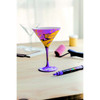Posca pc-5m (pc5m) Paint Marker Pens in A Bundle of 57 Individual Colours
The PC-5M's versatile bullet tip offers unlimited freedom of use. It adapts to all types of creation.The 1.8mm - 2.5mm medium tip of the PC-5M is the most versatile in the POSCA range. Providing a clear, precise line and beautiful colour, it is appreciated by both professionals and amateurs.
The PC-5M suits all sorts of people: artists and creative professionals such as architects and designers; fans of creative hobbies and home decoration; surfers and skaters wanting a new look for their boards. Its ease of use makes it ideal for beginners to explore their creativity.
- Versatile -With its 1.8–2.5mm tip, the PC-5M offers wide freedom of use.
- Multi-purpose -It is ideal for customising porous, irregular surfaces such as wood, stone, concrete etc.
- Extensive -It is available in the widest variety of colours in the range:
- 57 shades, consisting of 28x standard, 8x metallic, 4x fluorescent, 5x pastel and 12x deep shade colour pens.
- Convenient - Its tip is easily reversible.
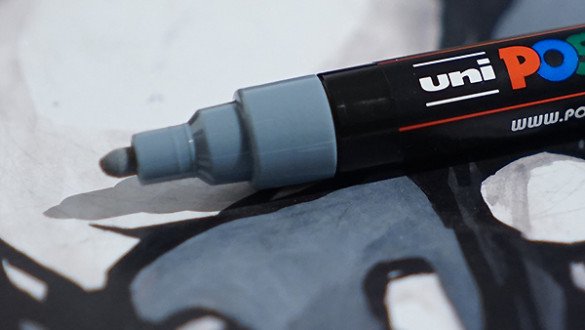
THE TIP -The link between the artist and the work
The POSCA range includes no fewer than eight sizes and five different tip shapes. Made either of acrylic or plastic, they are all ultra-hardwearing and perfectly suited to their respective uses. The very high quality of the materials used guarantees a stroke that is always perfectly smooth. The line is regular, the action is unique and the pleasure of creating with POSCA is unparalleled.

THE VALVE MECHANISM -POSCA comes to life!
MITSUBISHI PENCIL has developed a unique valve mechanism that guarantees a perfect seal for the marker and conserves the paint over time.
The same mechanism is used to prime the POSCA for use and to re-saturate the tip as often as necessary during creation.
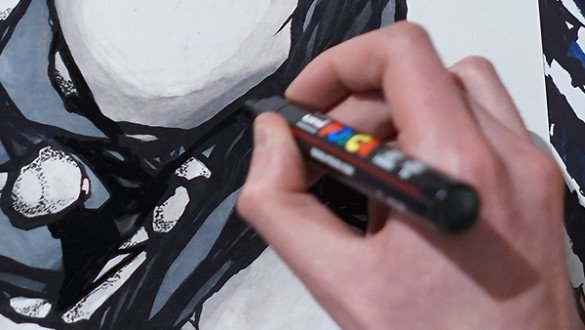
PAINT -The heart of POSCA!
Very rich in pigments, POSCA paint provides results of incomparable density. Its unique water-based formulation delivers bright, matte, opaque colours that withstand the passage of time. It has no odour.Layerable, mixable, water-soluble, weather-resistant… no fewer than 55 colours (some with glitter, metallic or fluorescent) offer unlimited creative possibilities.
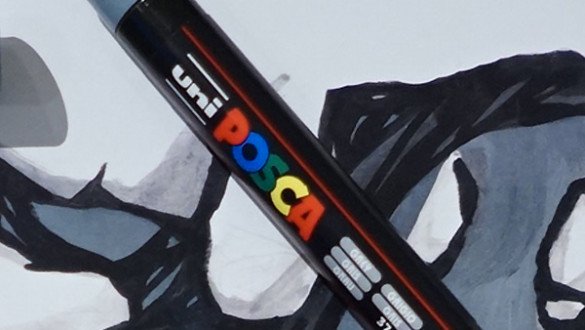
THE BODY -An iconic design!
From near or far, POSCA is instantly recognisable. Its deep black body, the five coloured letters of its logo (three primary and one secondary) and the UNI signature are inimitable. Sized differently based on the tip of the marker, the body shape enables an easy, comfortable grip.
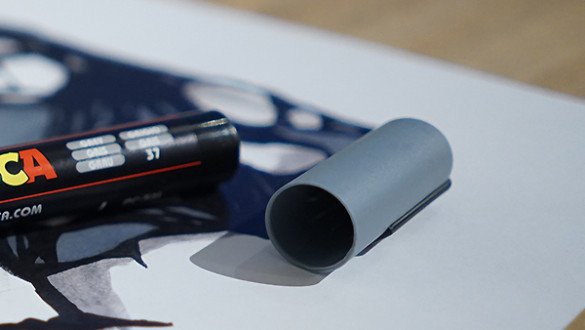
THE CAP -An explosion of colours!
The sealed cap ensures a long life for the marker. Conveniently, its colour (or the colour of the pocket tab, depending on the model) shows the colour of the paint. The caps of a handful of POSCA markers on a table are a visual treat and the promise of a highly colourful creation!
About The Effects With Posca:

WATER SOLUBLE -POSCA paint is “water-soluble”: it can be diluted to produce a gradient effect.
The operation takes place before drying: use a brush that has been soaked in water beforehand and work the paint directly on the material to get the effect you want.
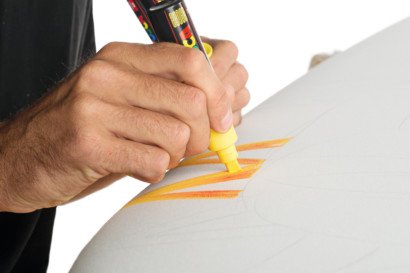
MIXABLE -As long as the paint is wet, colours can be mixed on the work surface by blurring with the tip or a brush to create infinite gradations of colour. If the tip is stained, just clean it and re-prime the marker to restore the initial colour.
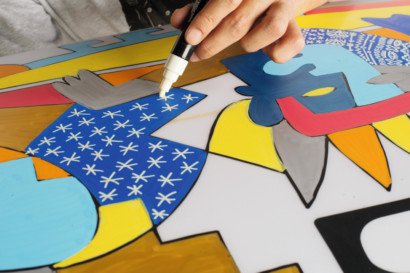
LAYERABLE -Dense and opaque, POSCA paint is ideal for layering!
Dark colours can be applied over light colours or light colours over dark. Thanks to its fast drying time, layering can be carried out with no smudges.

BLOWING -The “blowing” technique gives the gradient effect seen in street art, similar to the effect obtained with spray paints.
Just blow vigorously (but not too vigorously!) on the tip of the POSCA when it is filled with paint.
This technique works best with broad tips: PC-5M, PC-7M, PC-8K et PC-17K.
About Posca On Materials:
Posca, The Colours Of Creation! It is a paint marker popular with artists and creative hobbyists. It is an essential tool for creation and self-expression that is used by novice artists and professional artists every day on all different type of material.
Posca come in eight different sized tips with 5 complementary shapes, making the suitable for many purposes. Combiened with 55 colours, including metallic, fluorescent and glitter - it is the only go to marker for you!
Information about what it works on:
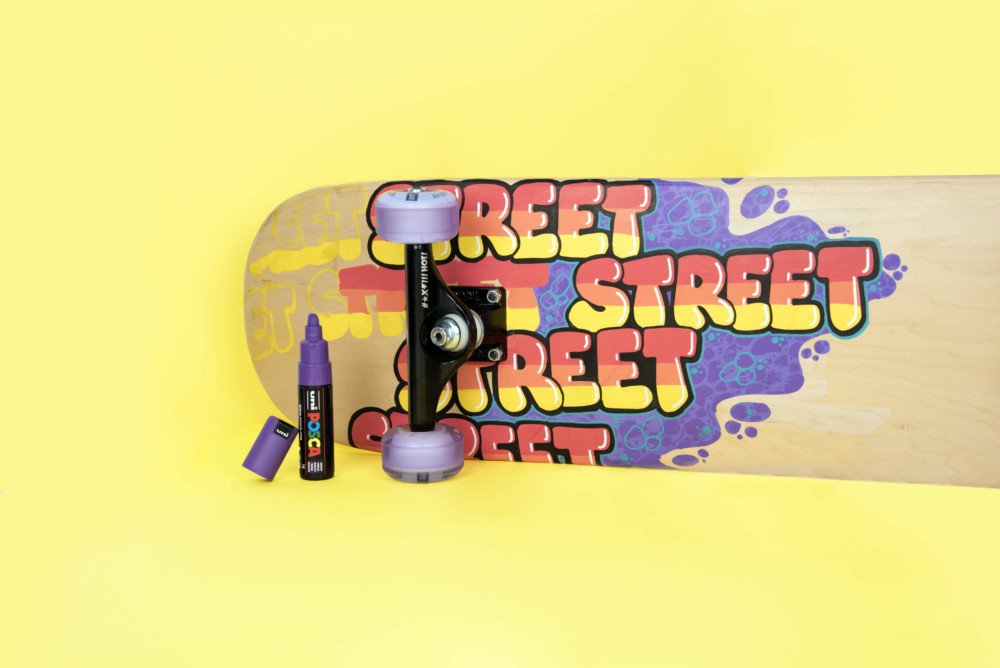
Wood
Warm and natural, wood is a material used in many forms and many contexts – decoration, customisation… It is an ideal complement for POSCA, whether rough or polished, for inspired creations both indoors and outdoors.
Preparation
On treated or varnished wood, it is advisable to roughen the surface with sandpaper before starting to work with POSCA. With recovered or recycled wood, it is a good idea to clean it first with water and a soft sponge and leave it to dry.
As wood is a porous natural material, it will absorb a lot of paint. Depending on the effect you want, several coats may be necessary.
Attachment
Once your creation is finished and dry, apply two coats of water-based spray varnish. Hold the can about 30 cm from the surface and spray in slow circular movements. The varnish can be matte or gloss depending on the look you want.
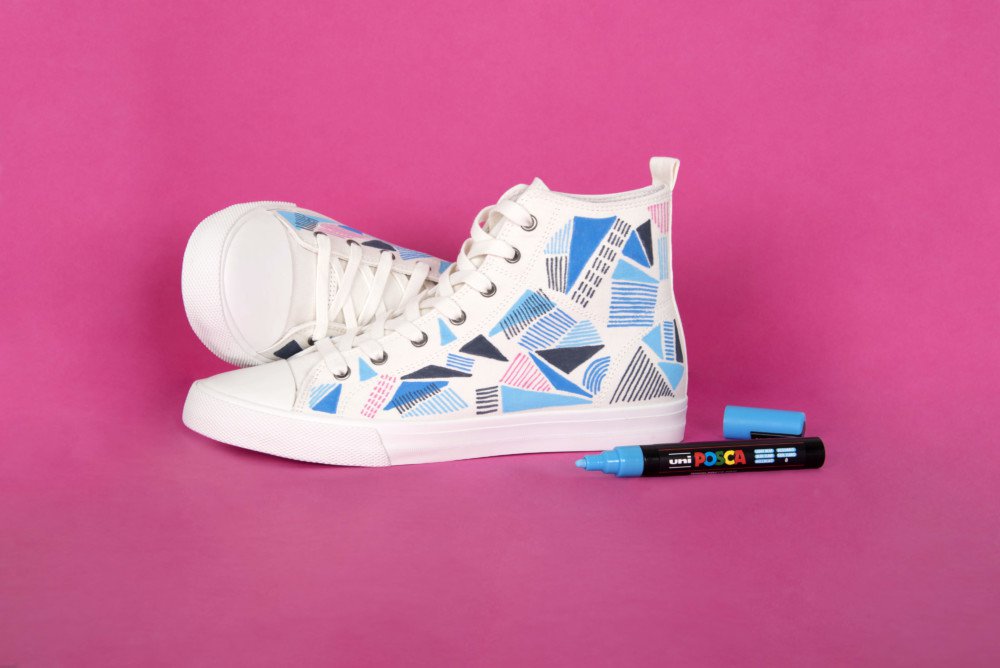
Fabric, Textiles And Skins
Whether natural or synthetic, textiles, fabrics and skins are materials with deep roots in all cultures.They are primarily used for clothing, soft furnishings and decoration.POSCA makes it easy to personalise and customise these everyday materials.What’s more, if you follow our fixing advice, you can make your creations permanent.
Preparation
Before starting to work on textiles, machine-wash the fabric to remove any industrial coatings if it is new or dirt if it is used.For skins such as natural or artificial leather, wipe with a humid sponge and leave to dry. For real or imitation suede, brush gently with a soft brush.
The effects you can produce with POSCA on textiles and skins include mixing and layering colours.POSCA will always be more heavily absorbed by natural materials. We recommend using an absorbent material beneath your surface (such as paper).The drying time and the number of coats you will need for a uniform result will vary and can be evaluated visually.
Fixation
Once your creation is finished and dry, you can iron it from the reverse side without using steam. Take care with the temperature of the iron depending on the fabric.You can place a sheet of greaseproof paper between the iron and the fabric for extra protection.If the fabric used is not suitable for ironing, you can fix your creation with a hair dryer. Hold it 30 cm from the surface and make small circular movements.
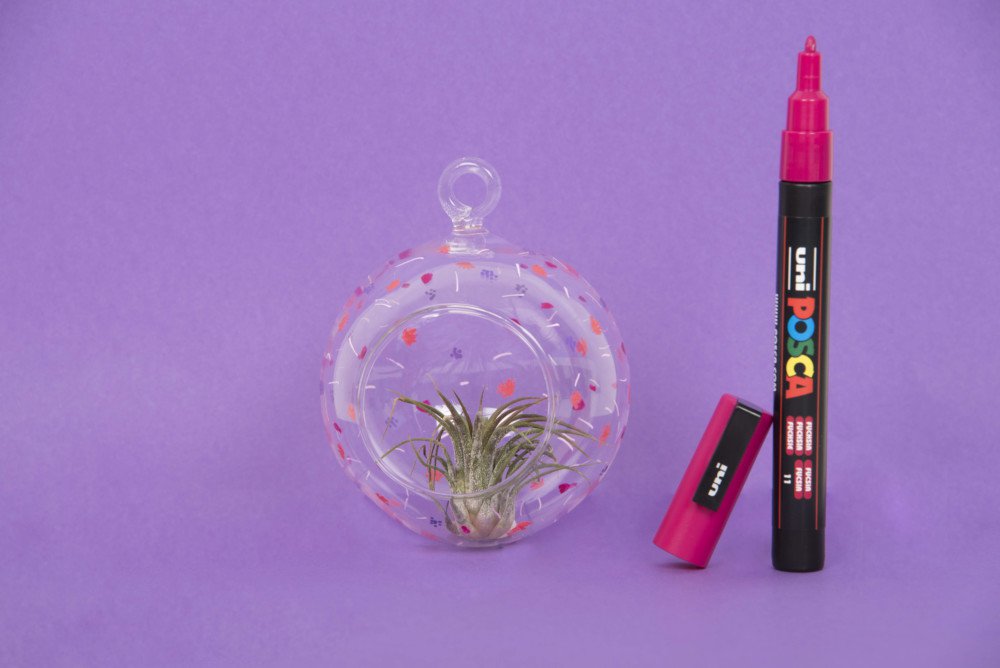
Glass
Transparent or translucent, glass is one of the most widespread manufactured materials.For hundreds of years, glass decoration has been a much-appreciated practice among artists of all backgrounds. Shop windows and museum displays are increasingly decorated and set off to perfection by professional and amateur artists.Glass decoration can now be found in the home, not just on windows but also on everyday items such as jugs, glasses, mirrors… (objects which, once decorated, can no longer be used in contact with food).POSCA is an excellent tool for all these projects: on glass, its colours gain new depth and luminosity, and it can be washed off with water whenever you want to start again.
Preparation
Clean the surface with a cloth and ensure it is not damp or greasy before starting work.Creations consisting only of lines will produce the best effect. In areas that need to be filled with colour, several coats will be needed for a uniform result, leaving a few minutes of drying time between coats.If you want to correct mistakes, just wipe the area to be erased with a damp cloth.
Fixation
You can make your creation permanent, though not for food use, by applying two coats of water-based spray varnish. Hold the can about 30 cm from the surface and spray in slow circular movements.The varnish can be matte or gloss depending on the look you want.
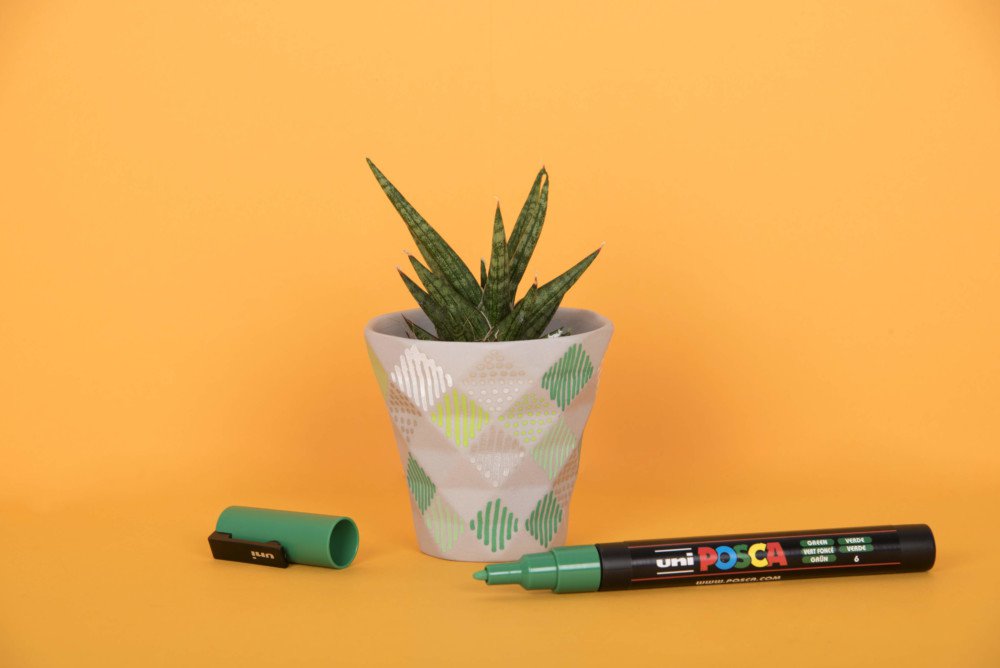
Ceramic
Pottery or earthenware, stoneware or glazed terracotta… there are many categories of ceramics. Most are made with fired clay.This medium, often associated with traditional crafts, provides fertile ground for many types of creation. POSCA is ideally suited to creativity using ceramics.Designs will be temporary if the ceramic is treated (e.g. glazed porcelain) or permanent otherwise (e.g. fired clay).Either way, if your ceramic objects were previously used with food, they are no longer food-safe after decoration.
Preparation
Clean the surface with a cloth and ensure it is dry before starting work.The effects you can produce with POSCA on ceramics include mixing and layering colours.If your ceramic is treated, the time POSCA paint takes to dry will be longer and creations based on lines will be more suitable. For areas filled with colour, several coats will be needed, leaving the paint to dry between coats.For rough ceramics, several coats will be needed for the whole design because the porous surface will absorb more paint.
Fixation
Once your creation is finished and dry, you can fix it.With treated ceramics, fix your creationfor non-food useusing a water-based spray varnish, spraying from about 30 cm in small circular movements.With rough ceramics, fire your creation in the oven. Heat the ceramic in the oven slowly to 220°, then turn off the oven and allow it to cool completely before taking it out.Fix the paint on porcelain in the same way, but to a temperature of 160° and for no more than 45 minutes.
To give your creation the longest possible life (for non-food use), you can apply a water-based varnish or adhesive varnish. Afterwards, wash only in cold water.

Paper Or Cardboard
Paper (from the Latin papyrus) is a natural medium for expression and creation. Made with plant fibres, it is a fundamental material for writing, drawing and painting.It is one of the POSCA marker’s closest allies – whether it is a basic sheet of paper, card, Bristol board, crêpe or even papier mâché, the paint adheres perfectly and permanently.
Preparation
No special preparation is needed to use POSCA on paper. For cardboard, remove any dust from the surface.All the POSCA techniques can be used on paper and cardboard. For a water colour effect, make sure the surface is thick enough, as the thinner the material, the more fragile it will be. Take care also with the amount of water you use on the material, and leave enough drying time to protect it.If you are drawing on photographic paper, the drying time will be longer.
Fixation
No special fixative is needed for POSCA on paper. However, to optimise conservation over time, you can apply a water-based spray varnish.Hold the can about 30 cm from the surface and spray in slow circular movements.The varnish can be matte or gloss depending on the look you want.
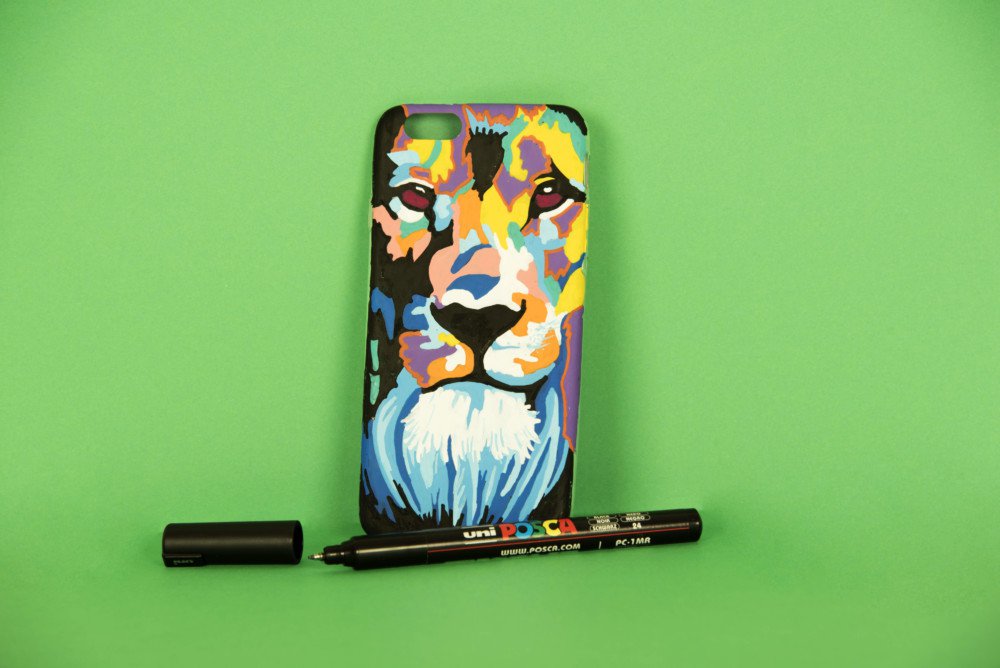
Plastic
Transparent or opaque, matte or glossy – plastics are now part of our everyday lives and cry out to be personalised!POSCA paint adheres perfectly to plastic, enabling the most original creations without frustration.
Preparation
No special preparation is needed to use POSCA on plastic. However, we recommend removing any dust or grease from the surface if necessary.The smoother the surface of the plastic, the less porous it is, and consequently the longer the drying time and the longer you will have to wait before handling your creation.
Fixation
Once your creation is finished and dry, apply two coats of water-based spray varnish. Hold the can about 30 cm from the surface and spray in slow circular movements.The varnish can be matte or gloss depending on the look you want.
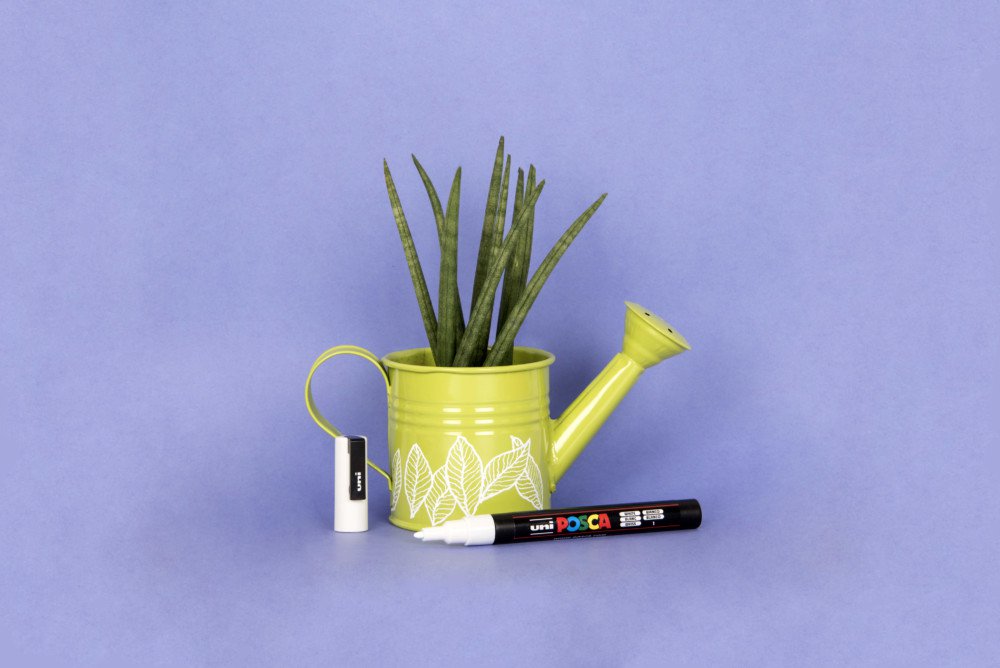
Metals
Glossy or matte, metal has been an artistic medium since ancient times, for jewellery making for example, or for tools and instruments.It is now widely used as a medium for decoration and customisation.POSCA adheres very well to metals such as iron or aluminium. The colour will be permanent on rough or porous metals and erasable on perfectly smooth metals.
Preparation
Clean the surface with a cloth and ensure it is not damp or greasy before starting work.The effects you can produce with POSCA on metals include mixing and layering colours.If the metal used is varnished, the drying time will be longer.
Fixation
Once your creation is finished and dry, we recommend applying two or three coats of water-based spray finishing varnish, especially for outdoor use.Hold the can about 30 cm from the surface and spray in slow circular movements.The varnish can be matte or gloss depending on the look you want.
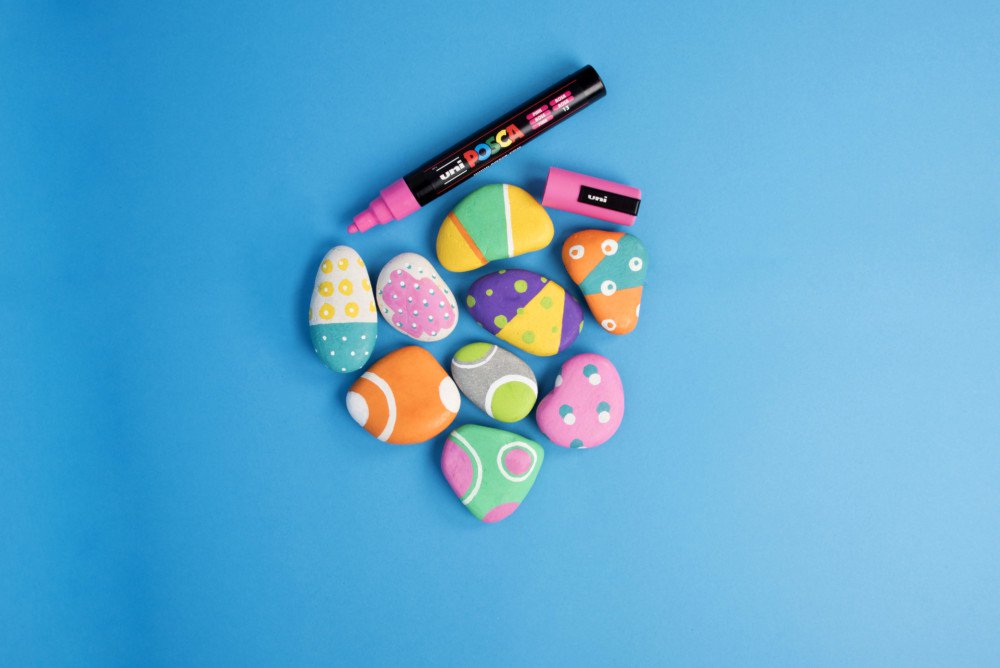
Minerals and Rocks
In their raw state or transformed by humans, mineral materials are without doubt the most widely available medium all around us!From natural stone to concrete walls via rocks and pebbles of all kinds and shapes, mineral materials offer an easy way to let your imagination run wild with POSCA.As long as you respect the environment and public property, of course, minerals represent an inexhaustible source of materials for permanent creation.
Preparation
Clean the surface with a cloth and ensure it is not damp before starting work.As mineral materials are naturally porous, they will absorb the paint to a greater or lesser degree depending on their nature.Depending on the effect you want, several coats may be necessary.
Fixation
Once your creation is finished and dry, you can apply two coats of water-based spray varnish to fix the results.Hold the can about 30 cm from the surface and spray in slow circular movements.The varnish can be matte or gloss depending on the look you want.
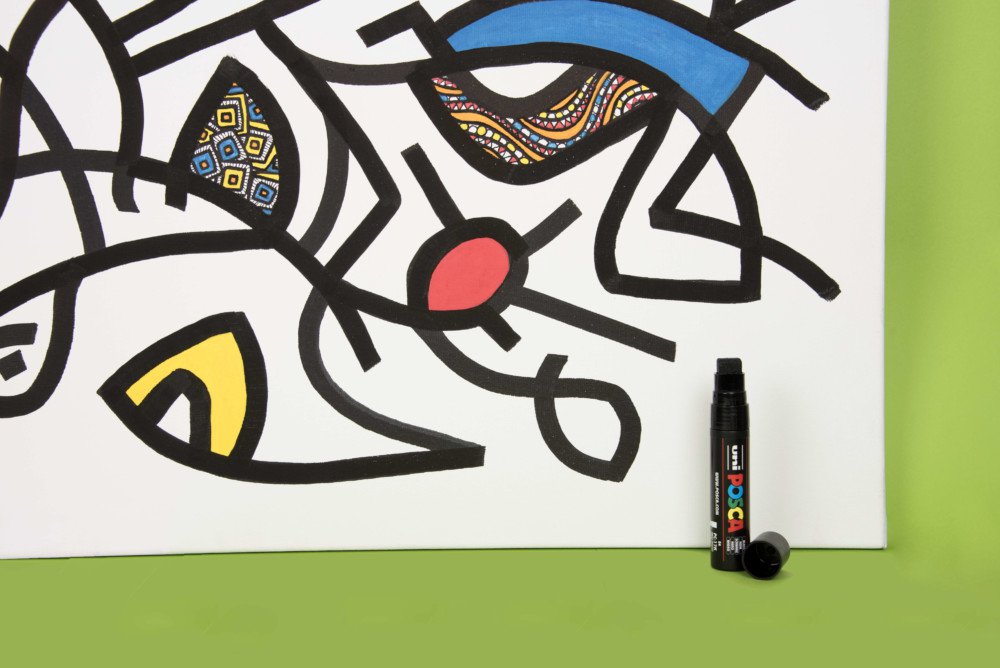
Canvas
Generally made with linen fibres, or sometimes hemp, canvas is the quintessential artistic medium. It is prized by professional artists and budding painters alike for its noble artistic heritage.Historically associated with classical painting, canvas is now a medium for totally contemporary creation, including street art.POSCA is intrinsically compatible with this medium, creating immediately permanent results.
Preparation
Make sure the canvas is properly primed before starting work.All the POSCA techniques and effects can be used on canvas.
Fixation
No special fixative is needed for POSCA on canvas, but if you want to optimise conservation over time, you can apply a water-based spray varnish. Hold the can about 30 cm from the surface and spray in slow circular movements.The varnish can be matte or gloss depending on the look you want.


























